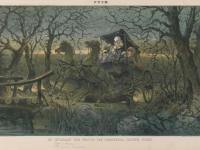Answer: Puck
America's first successful humor magazine was Puck, cofounded by the Austrian cartoonist Joseph Keppler in 1876. Keppler's work stood in stark contrast to Thomas Nast's – one of the foremost cartoonists at the time. Whereas Nast's cartoons were wood engraved in black and white, Keppler's were lithographed in colors. Whereas Nast's cartoons were dogmatic, Keppler's were satiric, reflecting the motto of his magazine: "What Fools These Mortals Be!"
Puck and its stable of artists were credited with denying Ulysses Grant a third term in 1880 and helping to elect Grover Cleveland president in 1884. Puck's success ushered in 20 years' worth of colorful imitators and inspired aggressive newspaper publishers such as Joseph Pulitzer of the New York World and William Randolph Hearst of the New York Journal to co-opt Puck's audience with colorful comic pages of their own. Meanwhile, advances in printing technology finally made it possible for them to print political cartoons created the day before on their front pages.
The Historical Society of Pennsylvania cartoons and caricatures collection [3133] spanning almost two hundred years of imagery mostly lampooning local, national, and international political issues. Comprising the collection are reproductions of eighteenth century cartoons, prints and clippings of nineteenth and twentieth century cartoons, and a number of original drawings of cartoons that appears in newspapers during the mid 1930s. Researchers will also find political cartoons and other caricatures in the Historical Society of Pennsylvania medium graphics collection [V64] and Balch Broadsides: Satirical Cartoons [PG278] collections.
HSP's newest digital history exhibit, Politics in Graphic Detail: Exploring American History Through Political Cartoons, features over 125 richly-annotated political cartoons from the collections, from Benjamin Franklin's "Join or Die", to the pillorying work of Thomas Nast.
Please join HSP on Wednesday, September 16, at 6:00 p.m. as project staff demonstrate the new exhibit’s features and functions. A document display of political cartoons from the collections – including an original Thomas Nast artwork, “The Silence of Matt Quay,” – and a reception will follow the demonstration.

